WORKED OUT EXAMPLE .
15. Consider a cubical vessel of edge a having a small hole is one of its walls. The total thermal resistance of the walls is r.
At time t = 0, it contains air at atmospheric pressure pa and temperature T0. The temperature of the surrounding air is
Ta(>T0). Find the amount of the gas (in moles) in the vessel at time t. Take Cv of air to be 5 R/2.
Sol. As the gas can leak out of hole, the pressure inside the vessel will be equal to the atmospheric pressure pa.
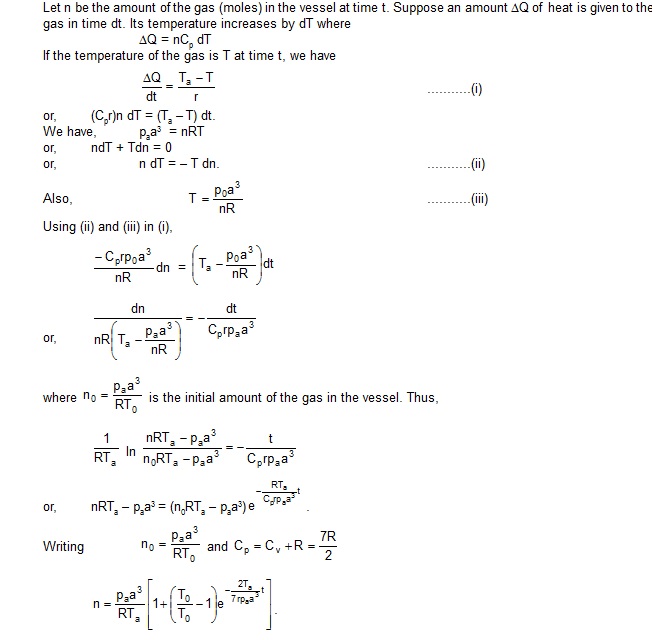 .
.
16. A blackbody of surface area 1 cm2 is placed inside an enclosure. The enclosure has a constant temperature
27ºC and the blackbody is maintained at 327ºC by heating it electrically. What electric power is needed to
maintain the temperature? s = 6.0 × 10–8 W/m2 –K4.
Sol. The area of the blackbody is A = 10–4 m2, its temperature is T1 = 327ºC = 600 K and the temperature of
the enclosure is T2 = 27ºC = 300 K. The blackbody emits radiation at the rate of AST14. The radiation falls
on it (and gets absorbed) at the rate of AsT24. The net rate of loss of energy is AS(T14 – T24). The heater
must supply this much of power. Thus, the power needed is As(T14 – T24)
= (10–4 m2) (6.0 × 10–8 W/m2 – K4) [(600 K)4 – (300 K)4]
= 0.73 W.
17. An electric heater emits 1000W of thermal radiation. The coil has a surface area of 0.020 m2. Assuming that the
coil radiates like a blackbody, find its temperature. s = 6.00 × 10–8 W/m2 – K4.
Sol. Let the temperature of the coil be T. The coil will emit readiation at a rate AsT4. Thus
1000 W = (0.020 m2) × (6.0 × 10–8 W/m2 – K4) × T4

18. The earth receives solar radiation at a rate of 8.2 J/cm2 – minute. Assuming that the sun radiates like a blackbody,
calculate the surface temperature of the sun. The angle subtended by the sun on the earth is 0.53º and the Stefan
constant s = 5.67 × 10–8 W/m2 – K4.
Sol.
Let the diameter of the sun be D and its distance from the earth be R. From the question
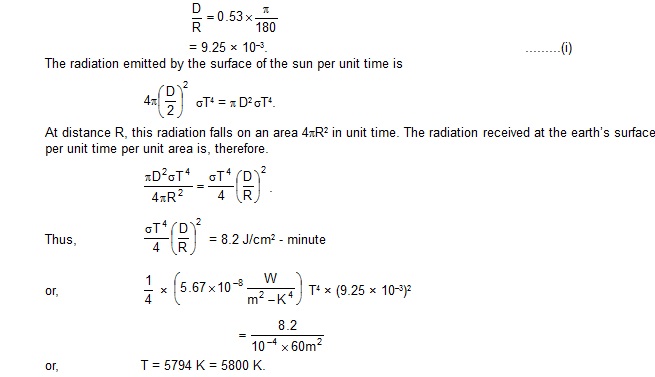
19. The temperature of a body falls from 40ºC to 36ºC in 5 minutes when placed in a surrounding of constant temperature
16ºC. Find the time taken for the temperature of the body to become 32ºC
Sol. As the temperature differences are small, we can use Newton’s law of cooling.

surrounding we have.
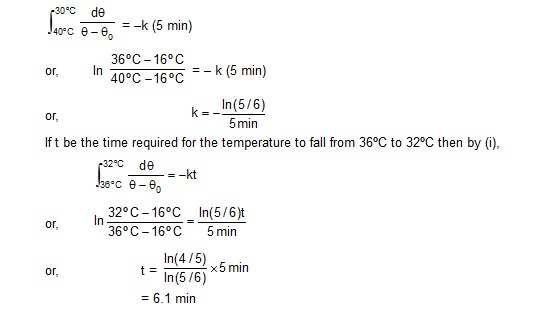
Alternative method
The mean temperature of the body as it cools from 40ºC to 36ºC is 40oC+36oC/2 = 38ºC. The rate of decrease of temperature is 40oC-36oC/5min = 0.80ºC/min.
Newton’s law of cooling is
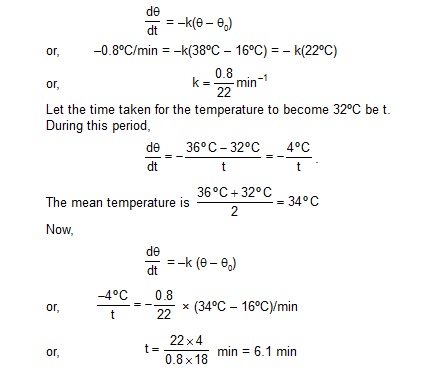
20. A hot body placed in air is cooled down according to Newton’s law of cooling, the rate of decrease of temperature
being k times the temperature difference from the surrounding. Starting from t = 0, find the time in which the body
will lose half the maximum heat it can lose.

at t = 0
Then,
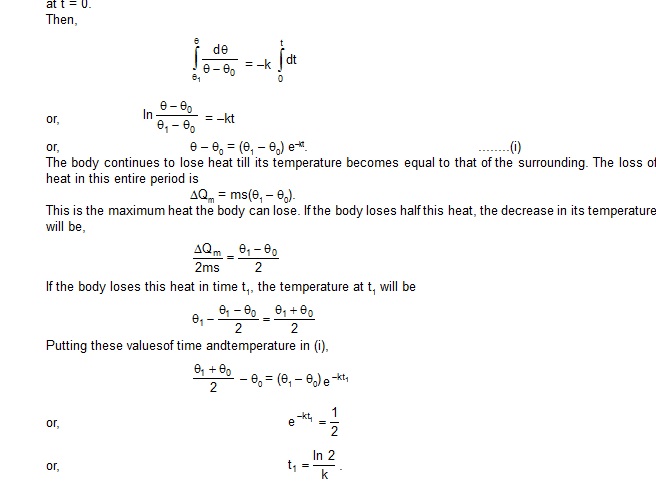
Exercise
1. A uniform slab of dimension 10cm × 10cm × 1cm is kept between two heat reservoirs at temperatures 10ºC and 90ºC.
The larger surface areas touch the reservoirs. The thermal conductivity of the material is 0.80 W/m–ºC. Find the amount
of heat flowing through the slab per minute.
Ans. 3840 J
2. A liquid-nitrogen container is made of a 1 cm thick thermocoal sheet having thermal conductivity 0.025 J/m–s–ºC.
Liquid nitrogen at 80 K is kept in it. A total area of 0.80m2 is in contact with the liquid nitrogen. The atmospheric
temperature is 300 K. Calculate the rate of heat flow from the atmosphere to the liquid nitrogen.
Ans. 440 W
3. The normal body-temperature of a person is 97ºF. Calculate the rate at which heat is flowing out of his body
through the clothes assuming the following values. Room temperature = 47ºF, surface of the body under clothes
= 1.6 m2, conducitivity of the cloth = 0.04 J/m–s–ºC, thickness of the cloth = 0.5 cm.
Ans. 356 J/s
4. Water is boiled in a container having a bottom of surface area 25cm2, thickness 1.0 mm and thermal conductivity 50 W/mºC,
100 g of water is converted into steam per minute in the steady state after the boiling starts. Assuming that no heat is lost to the
atmosphere, calculate the temperature of the lower surface of the bottom. Latent heat of vaporization of water = 2.26 × 106 J/kg.
Ans. 130°C
5. One end of a steel rod (K = 46 J/m–s–ºC) of length 1.0 m is kept in ice at 0ºC and the other end is kept in boiling water at 100ºC.
The area of cross–section of the rod is 0.04cm2. Assuming no heat loss to the atmosphere, find the mass of the ice melting per second.
Latent heat of fusion of ice = 3.36 × 105 J/kg.
Ans. 5.5 × 10–2 g
6. An icebox almost completely filled with ice at 0ºC is dipped into a large volume of water at 20ºC. The box has walls of surface area
2400cm2, thickness 2.0 mm and thermal conductivity 0.06 W/m–ºC. Calculate the rate at which the ice melts in the box.
Latent heat of fusion of ice = 3.4 × 105 J/kg.
Ans. 1.5 kg/h
7. A pitcher with 1mm thick porous walls contains 10 kg of water. Water comes to its outer surface and evaporates at the rate of 0.1 g/s.
The surface area of the pitcher (one side) = 200 cm2. The room temperature = 42ºC, latent heat of vaporization = 2.27 × 106J/kg, and
the thermal conductivity of the porous walls = 0.80 J/m–s–ºC. Calculate the temperature of water in the pitcher when it attains a constant value.
Ans. 28°C
8. A steel frame (K = 45 W/m–ºC) of total length 60cm and cross-sectional area 0.20 cm2, forms three sides of a square. The free ends are
maintained at 20ºC and 40ºC. Find the rate of heat flow through a cross-section of the frame.
Ans. 0.03 W
9. Water at 50ºC is filled in a closed cylindrical vessel of height 10 cm and cross-sectional area 10cm2. The walls of the vessel are adiabatic
but the flat parts are made of 1 mm thick aluminium (K = 200 J/m–s–ºC). Assume that the outside temperature is 20ºC. The density of water
is 1000 kg/m3, and the specific heat capacity of water = 4200 J/kg 0C. Estimate the time taken for the temperature to fall by 1.0ºC.
Make any simplifying assumptions you need but specific them.
Ans. 0.035 s
10. The left end of a copper rod (length = 20 cm, area of cross-section = 0.20cm2) is maintained at 20ºC and the right end is maintained at 80ºC.
Neglecting any loss of heat through radiation find (a) point 11 cm from the left end and (b) the heat current through the rod.
Thermal conductivity of copper = 385 W/m–ºC.
Ans. (a) 53°C (b) 2.31 J/s
11. The ends of a metre stick are maintained at 100ºC and 0ºC. One end of a rod is maintained at 25ºC. Where should its other end be
touched on the metre stick so that there is no heat current in the rod in steady state?
Ans. 25 cm from the cold end.
12. A cubical box of volume 216 cm3 is made up of 0.1 cm thick wood. The inside is heated electrically by a 100 W heater. It is found that the
temperature difference between the inside and the outside surface is 5ºC in steady state. Assuming that the entire electrical energy spent appears
as heat, find the thermal conductivity of the material of the box.
Ans. 0.92 W/m–°C
13. Figure shows water in a container having 2.00 mm thick walls made of a material of thermal conductivity 0.50 W/m–ºC. The container is
kept in a melting-ice bath at 0ºC. The total surface area in contact with water is 0.05 m2. A wheel is clampled inside the water and is coupled
to a block of mass M as shown in the figure. As the block goes down, the wheel rotates. It is found that after some time a steady state is reached
in which the block goes down with a constant speed of 10cm/s and the temperature of the water remains constant at 1.0C. Find the mass M of
the block. Assume that the heat flows out of the water only through the walls in constant. Take g = 10 m/s2.
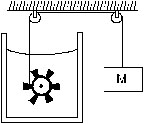
Ans. 12.5 kg
14. On a winter day when the atmospheric temperature drops to –10ºC, ice forms on the surface of a lake. (a) Calculate the rate of increase
of thickness of the ice when 10 cm of ice is already formed. (b) Calculate the total time taken in forming 10cm of ice. Assume that the
temperature of the entire water reaches 0ºC before the ice starts forming. Density of water = 1000kg/m3, latent heat of fusion of ice
= 3.36 × 105 J/kg and thermal conducitivty of ice = 1.7 W/m–ºC. Neglect the expansion of water on freezing.
Ans. (a) 5.0 × 10–7 m/s
(b) 27.5 hours
15. Consider the situation of the previous problem. Assume that the temperatures of the water at the bottom of the lake remains constant
at 4ºC as the ice forms on the surface(the heat required to maintain the temperature of the bottom layer may come from the bed of the lake).
The depth of the lake is 1.0m. Show that the thickness of the ice formed attains a steady state maximum value. Find this value. The thermal
conductivity of water = 0.50 W/m–ºC. Take other relevant data from the previous problem.
Ans. 89 cm
16. Three rods of lengths 20cm each and area of cross-section 1 cm2 are joined to form a triangle ABC. The conductivities of the rods are
KAB = 50 J/m–s–ºC, KBC = 200 J/m–s–°C and KAC = 400 J/m–s–°C. The junction A, B and C are maintained at 40°C, 80°C and 80°C
respectively. Find the rate of heat flowing through the rods AB, AC and BC.
Ans. 1 W, 8 W, zero
17. A semicircular rod is joined at its end to a straight rod of the same material and the the same cross-sectional area. The straight rod forms a
diameter of the other rod. The junctions are maintained at different temperatures. Find the ratio of the heat transferred through a cross-section
of the semicircular rod to the heat transferred through a cross-section of the straight rod in a given time.
Ans. 2 : p
18. A metal rod of cross-sectional area 1.0 cm2 is being heated at one end. At one time, the temperature gradient is 5.0°C/cm at cross-section
A and is 2.5°C/cm at cross-section B. Calculate the rate at which the temperature is increasing in the part AB of the rod. The heat capacity
of the part AB = 0.40 J/°C, thermal conductivity of the material of the rod = 200 W/m–°C. Neglect any loss of heat to the atmosphere.
Ans. 12.5°C/s
19. Steam at 120°C is continuously passed through a 50 cm long rubber tub of inner and outer radii
1.0 cm and 1.2 cm. The room temperature is 30°C. Calculate the rate of heat flow through the walls of the tube. Thermal conductivity
of rubber = 0.15 J/m–s–°C.
Ans. 233 J/s

21. A hollow tube has a length l, inner radius R1 and outer radius R2. The material has thermal conductivity K. Find the heat flowing
through the walls of the tube if (a) the flat ends are maintained at temperatures T1 and T2 (T2 > T1) (b) the inside of the tube is
maintained at temperature T1 and the outside is maintained at T2.

22. A composite slab is prepared by pasting two plates of thicknesses L1 and L2 and thermal conductivities K1 and K2.
The slabs have equal cross-sectional area. Find the equivalent conductivity of the slab.
Ans. K1K2(L1+L2)/ L1L2+L2K1
23. Figure shows a copper rod joined to a steel rod. The rods have equal length and equal cross-sectional area. The free end of the copper
rod is kept at 0°C and that of the steel rod is kept at 100°C. Find the temperature at the junction of the rods. Conductivity of copper
= 390 W/m–°C and that of steel = 46 W/m–°C.
Ans. 10.6°C
24. An aluminium rod and a copper rod of equal length 1.0 m and cross-sectional area 1 cm2 are welded together as shown in figure.
One end is kept at a temperature of 20°C and the other at 60°C. Calculate the amount of heat taken out per second from the hot end.
Thermal conductivity of aluminium = 200 W/m–°C and of copper = 390 W/m–°C.
Ans. 2.36 J
25. Figure shows an aluminium rod joined to a copper rod. Each of the rods has length of 20 cm and area of cross-section 0.20 cm2.
The junction is maintained at a constant temperature 40°C and the two ends are maintained at 80°C. Calculate the amount of heat
taken out from the cold junction in one minute after the steady state is reached. The conductivities are KAt = 200 W/m–°C and KCu = 400 W/m–°C.
Ans. 144 J
26. Consider the situation shown in figure. The frams is made of the same material and has a uniform cross-sectional area everywhere.
Calculate the amount of heat flowing per second through a cross-section of the bent part if the total heat taken out per second from the end at 100°C is 130 J.
Ans. 60 J
27. Suppose the bent part of the frams of the previous problem has a thermal conductivity of
780 J/m–s–°C whereas it is 390 J/m–s–°C for the straight part. Calculate the ratio of the rate of heat flow
through the bent part to the rate of heat flow through the straight part.
Ans. 12 : 7
28. A room has a window fitted with a single 1.0 m × 2.0 m glass of thickness 2 mm. (a) Calculate the rate of heat flow through
the closed window when the temperature inside the room is 32°C and that outside is 40°C. (b) The glass is now replaced by two glasspanes,
each having a thickness of 1mm and separated by a distance of 1 mm. Calculate the rate of heat flow under the same conditions of temperature.
Thermal conductivity of window glass = 1.0 J/m–s–°C and that of air = 0.025 J/m–s–°C.
Ans. (a) 8000 J/s (b) 381 J/s
29. The two rods shown in figure have identical geometrial dimensions. They are in contact with two het baths at temperatures 100°C and 0°C.
The temperature of the junction is 70°C. Find the temperature of the junction if the rods are interchanged.
Ans. 30°C
30. The three rods shown in figure have identical geometrical dimensions. Heat flows from the hot end at a rate of 40 W in the arrangement (a).
Find the rates of heat flow when the rods are joined as in arrangement (b) and in (c) Thermal conductivities of aluminium and copper are
200 W/m–°C and 400 W/m–°C respectively.
Ans. 75 W, 400 W
31. Four identical rods AB, CD, CF and DE are joined as shown in figure. The length, cross-sectional area and thermal conductivity of each rod are l,
A and K respectively. The ends A, E and F are maintained at temperatures T1, T2 and T3 respectively. Assuming no loss of heat to the atmosphere,
find the temperature at B.
Ans. 3T1+2(T2+T3)/7
32. Seven rods A, B, C, D, E, F and G are joined as shown in figure. All the rods have equal cross-sectional area A and length l.
The thermal conductivities of the rods are KA = KC = K0, KB = KD = 2K0, KE = 3K0, KF = 4K0 and KG = 5K0. The rod E is
kept at a constant temperature T1 and the rod G is kept at a constant temperature T2(T2 > T1).
(a) Show that the rod F has auniform temperature T = (T1 + 2T2)/3.
(b) Find the rate of heat flow from the source which maintains the temperature T2.

Ans. 4K0A(T2-T1)/3l
33. Find the rate of heat flow through a cross-section of the rod shown in figure (q2 > q1). Thermal conductivity of the material of the rod is K.


34. A rod of negligible heat capacity has length 20 cm, area of cross-section 1.0 cm2 and thermal conductivity 200 W/m–°C.
The temperature of one end is maintained at 0°C and that of the other end is slowly and linearly varied from 0°C to 60°C in
10 minutes. Assuming no loss of heat through the sides, find the total heat transmitted through the rod in these 10 minutes.
Ans. 1800 J
35. A hollow metallic sphere of radius 20 cm surrounds a concentric metallic sphere of radius 5 cm. The space between the
two spheres is filled with a nonmetallic material. The inner and outer spheres are maintained at 50°C and 10°C respectively
and it is found that 100 J of heat passes from the inner sphere to the outer sphere per second. Find the thermal conductivity
of the material between the spheres.
Ans. 3.0 W/m–°C
36. Figure shows two adiabatic vessels, each containing a mass m of water at different temperatures. The ends of a metal rod
of length L, area of cross-section A and thermal conductivity K, are insertd in the water as shown in the figure. Find the time
taken for the difference between the temperatures in the vessels to become half of the original value. The specific heat capacity
of water is s. Nelgect the heat capacity of the rod and the container and any loss of heat to the atmosphere.
Ans. Lms/2KA In 2
37. Two bodies of masses m1 and m2 and specific heat capacities s1 and s2 are connected by a rod of length l, cross-sectional area A,
thermal conductivity K and negligible heat capacity. The whole system is thermally insulated. At time t = 0, the temperature of the
first body is T1 and the temperature of the second body is T2(T2 > T1). Find the temperature difference between the two bodies at time t.
Ans. (T2 – T1) e–lt where l = KA(m1s1+m2s2)/lm1m2s1s2
38. An amount n (in moles) of a monatomic gas at an initial temperature T0 is enclosed in a cylindrical vessel fitted with a light piston.
The surrounding air has a temperature Ts(> T0) and the atmospheric pressure is pa. Heat may be conducted between the surrounding
and the gas through the bottom of the cylinder. The bottom has a surface area A, thickness x and thermal conductivity K. Assuming
all changes to be slow, find the distance moved by the piston in time t.
Ans. (Ts – T0) (1 – e–2KAt/5 Rnx)
39. Assume that the total surface area of a human body is 1.6 m2 and that it radiates like an ideal radiator. Calculate the amount of energy
radiated per second by the body if the body temperature is 37°C. Stefan constant s is 6.0 × 10–8 W/m2–K4.
Ans. 887 J
40. Calculate the amount of heat radiated per second by a body of surface area 12 cm2 kept in thermal equilibrium in a room at temperature
20°C. The emissivity of the surface = 0.80 and s = 6.0 × 10–8 W/m2–K4.
Ans. 0.42 J
41. A solid aluminium sphere and a solid copper sphere of twice the radius are heated to the same temperature and are allowed to cool
under identical surrounding temperatures. Assume that the emissivity of both the sphere is the same. Find the ratio of
(a) the rate of heat loss from the aluminium sphere to the rate of heat loss from the copper sphere and
(b) the rate of fall of temperature of the aluminium sphere to the rate of fall of temperature of the copper sphere.
The specific heat capacity of aluminium = 900 J/kg–°C and that of copper = 390 J/kg–°C. The density of copper
= 3.4 times the density of aluminium.
Ans. (a) 1 : 4
(b) pcrcsc/parasa
42. A 100 W bulb has tungsten filament of total length 1.0 m and radius 4 × 10–5 m. The emissivity of the filament is 0.8
and s = 6.0 × 10–8 W/m2–K4. Calculate the temperature of the filament when the bulb is operating at correct wattage.
Ans. 1700 K
43. A spherical ball of surface area 20 cm2 absorbs any radiation that falls on it. It is suspended in a closed box maintained at 57°C.
(a) Find the amount of radiation falling on the ball per second.
(b) Find the net rate of heat flow to or from the ball at an instant when its temperature is 200°C. Stefan constant = 6.0 × 10–8 W/m2–K4.
Ans. (a) 1.4 J
(b) 4.58 W from the ball
44. A spherical tungsten piece of radius 1.0 cm is suspended in an evacuated chamber maintained at 300 k. The piece is maintained at
1000 K by heating it electrically. Find the rate at which the electrical energy must be supplied. The emissivity of tungsten is 0.30
and the stefan constant s is 6.0 × 10–8 W/m2–K4.
Ans. 22 W
45. A cubical block of mass 1.0 kg and edge 5.0 cm is heated to 227°C. It is kept in an evacuated chamber maintained at 27°C.
Assuming that the block emits radiation like a blackbody, find the rate at which the temperature of the block will decrease.
Specific heat capacity of the material of the block is 400 J/kg–K.
Ans. 0.12°C/s
46. A copper sphere is suspended in an evacuated chamber maintained at 300 K. The sphere is maintained at a constant temperature
of 500 K by heating it electrically. A total of 210 W of electric power is needed to do it. When the surface of the copper sphere
is completely blackened, 700 W is needed to maintain the same temperature of the sphere. Calculate the emisivity of copper.
Ans. 0.3
47. A spherical ball A of surface area 20 cm2 is kept at the centre of a hollow spherical shell B of area 80 cm2. The surface of A and
the inner surface of B emit as blackbodies. Assume that the thermal conductivity of the material of B is very poor and that of A is
very high and that the air between A and B has pumped out. The heat capacities of A and B are 42 J/°C and 82 J/°C respectively.
Initially, the temperature of A is 100°C and that of B is 20°C. Find the rate of change of temperature of A and that of B at this instant.
Explain the effects of the assumptions listed in the problem.
Ans. 0.05°C/s and 0.01°C/s
48. A cylindrical rod of length 50 cm and cross-sectional area 1 cm2 is fitted between a large ice chamber at 0°C and an evacuated chamber
maintained at 27°C as shown in figure. Only small portions of the rod are inside the chambers and the rest is thermally insulated from the
surrounding. The cross-section going into the evacuated chamber is blackened so that it completely absorbs any radiation falling on it.
The temperature of the blackened end is 17°C when steady state is reached. Stefan constant s = 6 × 10–8W/m2–K4. Find the thermal
conductivity of the material of the rod.

Ans. 1.8 W/m–°C
49. One end of a rod of length 20 cm is inserted in a furnace at 800 K. The sides of the rod are covered with an insulating material and
the other end emits radiation like a blackbody. The temperature of this end is 750 K in the steady state. The temperature of the
surrounding air is 300 K. Assuming radiation to be the only important mode of energy transfer between the surrounding and the
open end of the rod, find the thermal conductivity of the rod. Stefan constant s = 6.0 × 10–8 W/m2–K4.
Ans. 74 W/m–K
50. A calorimeter of negligible heat capacity contains 100 cc of water at 40°C. The water cools to 35°C in 5 minutes. The water is now
replaced by K-oil of equal volume at 40°C. Find the time taken for the temperature to become 35°C under similar conditions.
Specific heat capacities of water and K-oil are 4200 J/kg–K and 2100 J/kg–K respectively. Density of K-oil = 800 kg/m3.
Ans. 2 min
51. A body cools down from 50°C to 45°C in 5 minutes and to 40°C in another 8 minutes. Find the temperature of the surrounding.
Ans. 34°C
52. A calorimeter contains 50 g of water at 50°C. The temperature falls to 45°C in 10 minutes. When the calorimeter contains 100 g
of water at 50°C, it takes 18 minutes for the temperature to become 45°C. Find the water equivalent of the calorimeter.
Ans. 12.5 g
53. A metal ball of mass 1 kg is heated by means of a 20 W heater in a room at 20°C. The temperature of the ball becomes steady at 50°C.
(a) Find the rate of loss of heat to the surrounding when the ball is at 50°C.
(b) Assuming Newton’s law of cooling, calculate the rate of loss of heat to the surrounding when the ball is at 30°C.
(c) Assume that the temperature of the ball rises uniformly from 20°C to 30°C in 5 minutes. Find the total loss of heat to the surrounding during this period.
(d) Calculate the specific heat capacity of the metal.
(b) 20/3 W (c) 1000 J (d) 500 J/kg–K
54. A metal block of heat capacity 80 J/°C placed in a room at 20°C is heated electrically. The heater is switched off when the temperature reaches 30°C.
The temperature of the block rises at the rate of 2°C/s just after the heater is switched on and falls at the rate of 0.2 °C/s just after the heater is switched off.
Assume Newton’s law of cooling to hold. (a) Find the power of the heater. (b) Find the power radiated by the block just after the heater is switched off.
(c) Find the power radiated by the block when the temperature of the block is 25°C. (d) Assuming that the power radiated at 25°C respresents the average
value in the heating process, find the time for which the heater was kept on.
